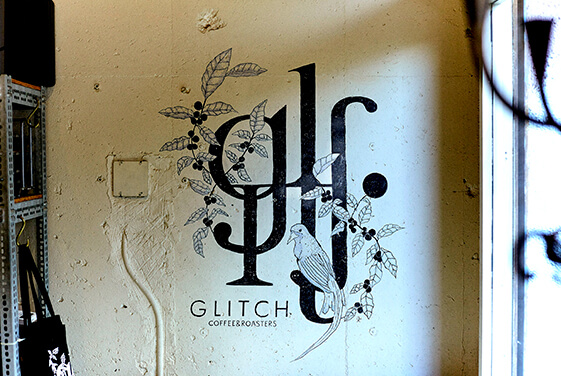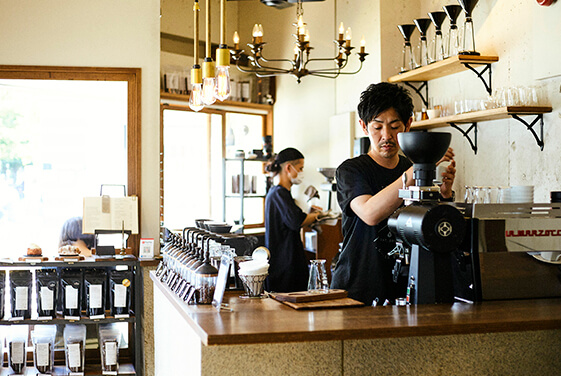This overwhelmingly fruity coffee overturns the conventional notion that coffee is bitter. This is GLITCH COFFEE & ROASTERS, a coffee shop and roastery founded in 2015 that operates three stores in Tokyo and Nagoya.
They are attracting attention as a darling of the times that brought a new trend to Japanese coffee, but when we interviewed the company's president, Suzuki Kiyokazu , we realized that this is only a one-sided view. GLITCH's popularity comes from their sincere attitude of giving back to the farms and Shin pursuit of the best coffee flavor, rather than chasing temporary trends or novelty.
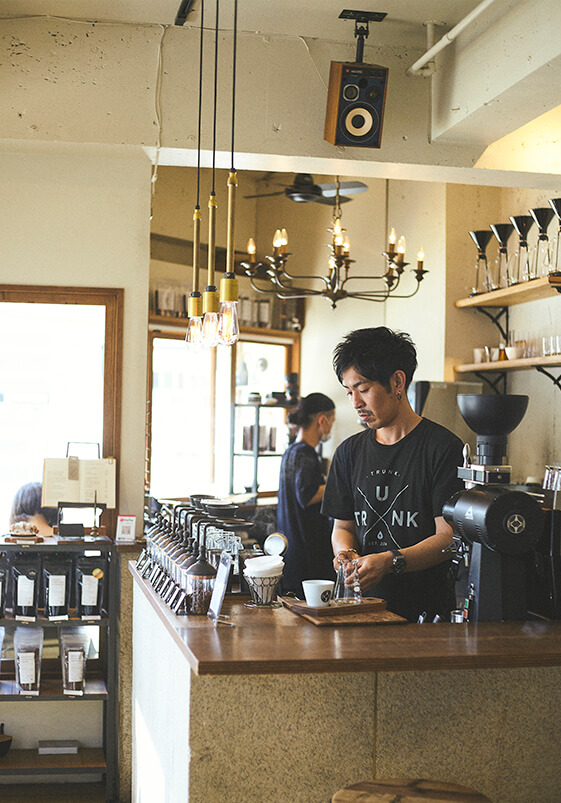
Admiring the craftsman

"At the age of 25, I had earned a national qualification in information processing and was working for a company, but I found myself in a situation where I didn't know what my dream was, so I started looking for a job that involved craftsmanship as a hobby. I had always wanted to do something artisanal, and after trying various things, I came across coffee."
Kiyokazu started to pursue a career in pottery and silver accessories at a time when Starbucks was becoming popular and baristas were becoming more prominent. However, she experienced a discrepancy in values between what she created and what others wanted.
One time, I gave a pottery piece I made to a friend, but he didn't seem very happy with it. If he doesn't understand what my friend likes or what his values are, he won't use it, and it wasn't something we could both agree on."
The thing that pleased them the most was the coffee that was brewed in a cup that they had made themselves.
"Because I was doing pottery and didn't have anything to put in my pottery, I started making hand-dripped coffee, and everyone said it was delicious. It was just ordinary coffee, nothing special. But I'd never had people be so pleased with my coffee or ask me to make it again, so I started to think this was interesting."
From barista training to roasting
From this experience, Manabu that a cup of coffee is shaped by various factors such as the origin of the beans, the extraction method, the job of the barista, etc., and I became fascinated by the depth of coffee. So I quit my job and trained as a barista for about two years, training under the Japanese Barista Champion and working at a roasting factory.
"At that time, I heard that Paul Bassett, the Australian world barista champion, was opening a shop in Japan, so I joined as a staff member. Some of the roasters who are still active at the forefront of coffee today were training there, and it's largely thanks to the relationships I built at that time that GLITCH has connections with so many different shops."
At the time, there were almost no shops that served coffee roasted in-house using single-origin beans like "Paul Bassett". It was said that this was an Australian culture that was introduced to Japan too early.
It was there that Kiyokazu first gained a deeper understanding of "roasting" and "single origin."
"I joined Paul Bassett about two years after I started working in the coffee industry. I wanted to learn about barista techniques, but I wanted to learn more about roasting techniques. So, in order to get Paul's approval, I trained morning, noon and night, sometimes without sleep. Maybe that got through to Paul, because he asked me if I wanted to try roasting."
However, in Australia, the thinking is on a division of labor. It is common for each position to be assigned to quality control, manager, store operation, barista, or roaster, and no two positions can be held at the same time. When asked "Do you want to be a barista or roast?" Kiyokazu answered without hesitation, "I want to roast." It was the moment he solidified his decision to make roasting his job.
Why we stick to black coffee
After continuing his training at Paul Bassett, Kiyokazu opened GLITCH COFFEE & ROASTERS in Jimbocho in 2015.
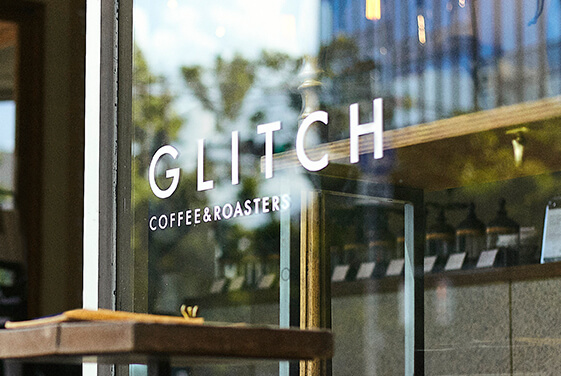
Kiyokazu , who describes himself as "more anxious than most people," had already built relationships with his coffee beans. He started his business after clarifying what he wanted to do, from roasting techniques, barista skills, human relationships, and the concept of his store.
The focus was on serving mainly black coffee and brewing it by hand drip. It is a completely different style of coffee from "Paul Bassett," which mainly serves espresso and cafe latte, and also offers blends. Kiyokazu envisioned the faces of the people working on the farm behind the coffee beans.
"I've actually visited the farms, but the farmers wouldn't say 'no' to blending, so they would look sad and say 'we have no say in that.' So I thought I wanted to make GLITCH a single-origin coffee.
Another thing is that consumers don't know the taste of each bean, so they can't judge what it will taste like if they mix them together. If we mix them together without understanding the characteristics of each origin, the efforts of the farmers will be wasted, and if we can't say which variety and which farm the beans come from, we won't be able to give back to the farmers properly."
Because it is single origin, we can give back to the farms. Naturally, we are more particular about the beans than anyone else. We are always looking for new beans, and this feeling is certainly conveyed to our customers.
"Some customers even remember the name of the farm and say, 'The coffee from that Ethiopian farm, Sakoro Farm, was delicious. Is there any this year?' I think it's very flattering for local people to hear someone specifically request a farm in Japan. It would be great to hear more comments like that."
The taste of a cup of coffee
The "effort" of many people put into this
"Humans only have a short time to live, right? It's important to be able to choose what you get at that time.

Even with coffee, I think there's a lot of effort missing for a 100-yen cup of coffee. What kind of beans are used, are the machines cleaned every day, when were they roasted, where did they originate from? You press a button to buy something you don't know.
Our coffee ranges in price from about 600 yen to about 3,500 yen, but the people at the farms work hard to produce high-quality beans. If you go to the farms, you can see their efforts, and they use methods that are completely different from other coffees.
I think the efforts of the people who bring it here also contribute to the flavor of the coffee.
Then, we roasters concentrate to bring out that flavor, and the barista extracts it to create a cup of coffee. When you think about it like that, I think the price of 600 yen is actually too cheap."
GLITCH may have the image of a niche store that offers special roasts and special flavors. However, that is because Kiyokazu -san has stuck to the policy of "not doing anything that I don't want to do." His strong desire to "let consumers know the original taste of coffee" is behind it.
Light roasting is for appreciating the flavor
It's just a technique
Another image that symbolizes GLITCH is that of a light roast. Kiyokazu says that light roasting is not just a trend, but is also necessary to determine the quality of the beans.
"Rather than just doing light roasts, if you want to know about single origins, you have to get to that roasting point. When cupping or tasting, you never taste a dark roast. If you want to know the quality of meat, it's easier to tell if it's rare rather than well-done. To determine whether it's good quality, you can't burn it too much."
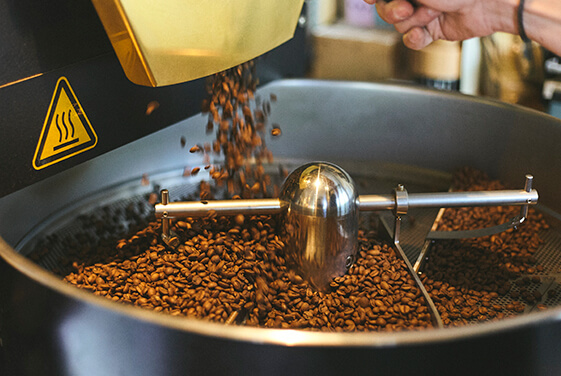
Cherishing the cafe's history
GLITCH has created a new trend in coffee, but when asked what the future holds for the company, the answer was a bit surprising.
"That's one of the reasons I opened my shop in Jimbocho, but there are so many great shops there, like Milonga Nuova and Saboru. Those are the kind of shops I think are cool.
No matter how popular new roasters or cafes become, they can't compete with the originality of a place like that, and they have deep ideas. I really empathize with that. After all, history and hard work are important."
GLITCH is steadily expanding, with two stores in Tokyo and one in Nagoya, but they say they don't want to increase the number any further. That's a typical GLITCH reason.
"If we open too many stores, we won't be able to create our own flavor. We'll reach our limits.
If possible, it would be best to have only one store. In order to create the flavor I want to create, I need to have an original store. Otherwise, everyone else will end up just copying me."
"GLITCH" overturns stereotypes
At GLITCH, Kiyokazu is the only one who roasts coffee and controls the quality. When I heard that, I thought he was a stubborn craftsman who said, "There's no one I can trust."
"Do you know what the word 'GLITCH' means? It means 'system bug'.
When you're the only one making and roasting coffee, you know within common sense that if you do it this way, it will turn out like this, so you end up forming fixed ideas.
Recently, I asked a staff member how he drinks coffee at home, and when I had him repeat the hand-drip method in the store, it was delicious. There are many things you can discover from things you don't know or never thought of. It's like discovering a 'bug'."
Kiyokazu -san says that he has been training his staff since before the shop opened. Although the shop has an image of being a stylish and strict coffee shop, which is a representative of light roast coffee, the roaster is flexible enough to incorporate the sensibilities of newcomers.
